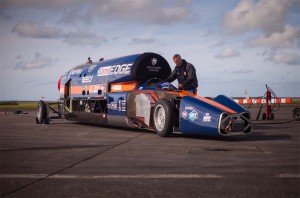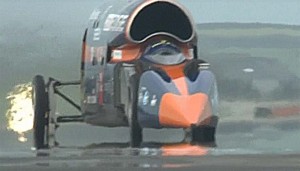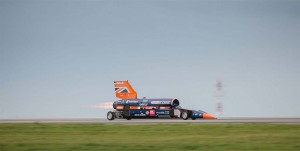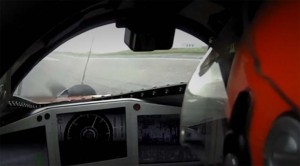At just 210 mph it wasn’t much of a run for either Andy Green or the Bloodhound. But the first test drive of the jet-powered car was a clear sign that everything is coming together for what will a race for the record books.
This month marks the 20th anniversary of Green’s first entry into the Guinness Book. On October 15, 1997, he became the first human to blast through the sound barrier in an earlier jet car, the ThrustSSC, reaching 714.144 miles per hour. Now, the 55-year-old Green is out to boost that number by more than 40 percent.
It has been 10 years since the Bloodhound Supersonic Car, or SSC, project was first conceived. But it only this month made its first test run at Cornwall Airport Newquay, Green assessing the event as “a proper workout for the vehicle.”
(A flying DeLorean? Yep. Click Here for more.)
Like the earlier ThrustSSC, the dart-shaped Bloodhound uses a jet engine for power, in this case a Rolls-Royce EJ200 lifted from a EuroFighter Typhoon jet. Originally introduced in 2003, in service they can produce as much as 20,000 pound-feet of torque, more than enough to take the fighter past Mach 2. But this will be the first time the engine has been challenged with going supersonic on the ground. (Even in flight, the record for an airplane operating at low altitude is 994 mph.)
Running at 210 mph “is far below the car’s ultimate target of 1,000 mph,” said Green, adding that the Bloodhound “is designed for high speed on a desert rather than sprint performance off the line. But it still accelerated from zero to 210 mph in less than eight seconds.”
The Bloodhound is significantly different from the earlier ThrustSSC, with a single nacelle mounted above and behind the driver. There are no wings, of course, though aerodynamics matter just as much as they do on the Typhoon jet. In this case, the goal is keep the car pinned solidly to the ground as it races up to maximum speed. That poses particular problems, the original Thrust team learned, as a vehicle breaks through the sound barrier.
(Has the era of the flying car finally arrived. Click Here for more.)
Because of the way air flows across and around a craft, different portions – whether with an aircraft or a car – go supersonic before others, and that can create violent disturbances that have to be carefully managed. As with the EuroFighter, Green – a high-ranking British Royal Air Force pilot – will get assistance from a high-tech computer management system overseeing a variety of Bloodhound functions. But he still will have plenty of work to do, and managing the Bloodhound isn’t like driving any existing wheeled vehicle, even a Formula One racer. Consider what happened on the first test run.

Green runs a pre-check before the test. He was the first man to break the sound barrier in a car, the ThrustSSC.
“I discovered during the initial dynamic tests that to get the Car to 200mph, I would have to take my foot off the throttle at 130mph as it then carries on accelerating for another 2 seconds,” he said last. “And then to slow down, I need to apply gentle pressure to the brakes for 2 seconds to ‘warm up’ the carbon fiber disk brakes before applying full force on the brakes to stop the Car.”
That posed some challenges, as the Cornwall runway was only 2.7 kilometers in length, or just short of 9,000 feet.
Every part of the 39-foot, 11,000-pound Bloodhound will be stressed to the limits, especially those parts making contact with the ground. The test run was conducted on narrow wheels borrowed from another aircraft and using aviation-grade rubber tires. When it makes its run for the gold, however, the Bloodhound will use solid aluminum wheels, no conventional rubbed compound capable of standing up to the pressures – and heat – that would be generated.
By the time the Bloodhound will be ready for its record drive along a 12-mile course carved out of the Haksheen Pan flats in South Africa, there will be another critical change made. The EJ200 engine won’t have enough thrust to propel the car to 1,000 mph. So, at about 300 mph a rocket engine specially designed by Nammo will fire up. A third power source, a supercharged V-8 provided by Jaguar, will be used to pump oxidizer into the rocket engine.
The Bloodhound project got underway in 2008, and the final cost is expected to reach around 60 million British pounds, or US$79.2 million at the current exchange rate. Funding has come from a mix of public donations and corporate sponsors including Chinese automaker Geely and British aerospace firm Rolls-Royce.
The project has run into a series of obstacles over the years, an earlier propulsion system scrubbed due to cost. The original goal was to make the record run this month, a target date now pushed back until at least 2020.
(Volvo parent Geely buys Terrafugia flying car company. For the story, Click Here.)



